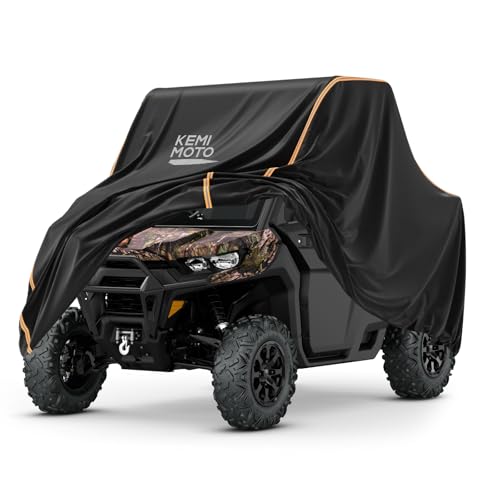Hey there, fellow outdoor enthusiasts! As the days grow shorter and the snow begins to fall, many of us start dreaming of winter adventures.
Whether it’s plowing a snowy driveway, hauling firewood, or simply exploring frosty trails, UTVs are our trusty companions.
But with the exciting rise of electric UTVs, a big question has emerged: how do these silent powerhouses really perform when the mercury drops?
I’ve been digging into this, and let me tell you, it’s a fascinating comparison.
We’re going to break down the nitty-gritty of electric versus gasoline UTV winter performance,
so you can make an informed decision for your cold-weather escapades.
The Rise of Electric UTVs
It wasn’t long ago that the idea of an electric UTV seemed like something out of a science fiction novel.
Yet, here we are, witnessing a quiet revolution in the off-road world.
Electric UTVs are no longer a niche concept; they’re a rapidly growing segment, offering some compelling advantages.
Think about it: the instant torque that makes climbing hills feel effortless, the near-silent operation that lets you appreciate nature without a roaring engine, and the undeniable appeal of zero tailpipe emissions.
For many, these benefits are a game-changer, promising a cleaner, quieter, and often more powerful off-road experience.
The interest in these vehicles is skyrocketing, and for good reason.
They represent a significant leap forward in technology and environmental consciousness.

Videos are added as random thoughts 💭 💭 💭 💭.
Electric UTVs in the Cold: The Challenges
Now, for the million-dollar question: can these electric wonders handle the harsh realities of winter?
While I’m a huge fan of the innovation, it’s crucial to be realistic about the challenges.
When the temperature plummets, electric UTVs, much like their four-wheeled electric car cousins, face some significant hurdles.
It’s not all doom and gloom, but it’s definitely something you need to be aware of before you commit.
Battery Performance: The Achilles’ Heel
Let’s talk about the heart of the matter: the battery.
In cold weather, the lithium-ion batteries that power most electric UTVs just don’t perform at their peak.
Think of it like trying to run a marathon in freezing temperatures – your body has to work a lot harder, and you won’t be as efficient.
The same goes for batteries.
The chemical reactions inside them slow down, which means less power and less capacity.
I’ve seen reports that a powersports battery can lose up to half of its power output at 0°F compared to a balmy 60°F.
That’s a massive drop, and it directly impacts your UTV’s ability to tackle tough winter tasks.
Charging also becomes a bit of a chore.
Cold batteries are more resistant to charging, so it can take significantly longer to top up.
Some advanced battery management systems will even prevent charging altogether if the battery is too cold, to avoid causing permanent damage.
It’s a necessary safety feature, but it can be a real inconvenience when you’re eager to get back out there.
Range Anxiety: A Winter Reality
If you’ve ever owned an electric vehicle, you’re probably familiar with “range anxiety.”
Well, in the winter, that anxiety can be amplified.
The combination of reduced battery capacity and increased energy consumption creates a perfect storm for a shorter driving range.
Not only does the battery itself hold less of a charge, but your UTV is also working harder.
Pushing through heavy snow creates more resistance, and if you’re using a cabin heater or a heated steering wheel (which, let’s be honest, you probably are), that’s even more power being diverted from the motor.
I’ve read some eye-opening statistics on this. Some studies show that an EV’s range can be slashed by as much as 57% in sub-zero temperatures.
While that’s a general EV statistic, it gives you a good idea of the kind of impact you can expect with an electric UTV.
That 50-mile range you were so excited about in the summer might suddenly become a much more modest 20-25 miles in the dead of winter.
It’s a significant reduction, and it’s something you absolutely have to plan for.
Motor Efficiency and Other Components
It’s not all bad news, though.
The electric motor itself is actually quite resilient in the cold. Unlike a gasoline engine,
it doesn’t have to worry about things like oil viscosity or fuel combustion.
However, other components in the drivetrain can be affected.
The lubricants in the gearbox and bearings can thicken in the cold, which can create a bit of extra drag and reduce overall efficiency.
It’s a minor factor compared to the battery issues, but it’s still part of the bigger picture.
Gasoline UTVs in Winter: A Traditional Perspective
So, with all these challenges facing electric UTVs in the cold, you might be wondering if good old-fashioned gasoline is the way to go.
It’s a fair question, and there’s no denying that gasoline-powered UTVs have a long and proven track record in winter conditions.
But they’re not without their own set of quirks.
I’ve spent plenty of time with both, and I can tell you that it’s not as simple as one being “better” than the other.
Starting and Running in the Cold
Anyone who has ever tried to start a carbureted engine on a frosty morning knows the struggle.
Cold, thick oil, a sluggish battery, and less volatile fuel can make for a frustrating start to your day.
Thankfully, modern fuel-injected gasoline UTVs have made this much less of an issue.
They’re generally much more reliable starters in the cold, but it’s still something to be aware of.
Once they’re running, though, gasoline engines have a distinct advantage: they generate their own heat.
This not only helps the engine run more efficiently but also provides a ready source of heat for the cabin.
Fuel Efficiency and Heating
Just like their electric counterparts, gasoline UTVs do see a dip in efficiency in the winter.
The colder, denser air can affect the air-fuel mixture, and it takes longer for the engine to reach its optimal operating temperature.

However, the drop in fuel efficiency is generally much less dramatic than the range reduction you see in electric UTVs.
You might lose a few miles per gallon, but you’re not likely to see your range cut in half.
And then there’s the heat.
This is a huge advantage for gasoline UTVs in the winter.
The waste heat from the engine can be easily channeled into the cabin, providing a powerful and consistent source of warmth.
This means you can stay comfortable without having to worry about draining your battery.
It’s a simple but significant advantage that can make a big difference on a long, cold day.
Range Consistency
When it comes to range, gasoline UTVs are the clear winners in the winter.
While their fuel efficiency might dip slightly, their overall range remains much more consistent than electric UTVs.
You can head out for a long day of riding with a much better idea of how far you’ll be able to go.
And if you do run low on fuel, you can simply top up from a gas can.
It’s a level of convenience and predictability that electric UTVs just can’t match in the cold – at least, not yet.
Key Factors for Optimal Winter Performance
Regardless of whether you choose an electric or gasoline UTV, there are several universal factors that will significantly impact your winter performance and overall enjoyment.
I always tell people that the machine is only as good as its weakest link, and in winter, those links can become very apparent.
Battery Management (for Electric UTVs)
For electric UTVs, advanced battery management systems are absolutely critical.
Look for models that offer features like battery pre-conditioning, which warms the battery to an optimal temperature before you even start your ride.
This can dramatically improve efficiency and range.
Keeping your UTV plugged in when not in use, especially in a heated garage, can also make a huge difference in battery readiness and longevity.
It’s all about keeping that battery happy and warm.
Motor and Drivetrain Considerations
While electric motors are generally robust, the entire drivetrain needs to be up to snuff for winter.
Sealed components are a must to keep out moisture and corrosive elements.
Proper lubrication, designed for cold temperatures, will ensure that all moving parts operate smoothly without excessive friction.
This applies to both electric and gasoline models, as cold can make any mechanical system sluggish.
The Importance of Winter-Specific Tires
This might seem obvious, but I can’t stress it enough: tires make all the difference.
All-season tires just won’t cut it when you’re dealing with deep snow, ice, and slush.
Invest in winter-specific tires with aggressive tread patterns and softer rubber compounds that remain pliable in the cold.
They provide superior traction, control, and safety, which is paramount when conditions are slick.
It’s like wearing sneakers on ice versus proper winter boots – there’s no comparison.
Efficient Heating Systems
For electric UTVs, efficient cabin heating is a delicate balance.
You want to stay warm, but you don’t want to drain your battery too quickly.
Some newer electric models are incorporating heat pumps, which are far more energy-efficient than traditional resistive heaters.
For gasoline UTVs, as I mentioned, the waste heat from the engine is a fantastic resource, but ensuring your cabin is well-sealed and insulated will maximize its effectiveness.
Comfort is key, especially on long winter days.
Charging Infrastructure (for Electric UTVs)
If you’re going electric, you need a solid plan for charging.
In remote winter locations, this can be a real challenge.
Having access to a heated garage or a reliable charging station is crucial.
Consider portable charging solutions if you plan on extended trips away from home base.

The convenience of simply refilling a gas tank is something electric UTV owners need to plan around carefully.
Vehicle Design (Enclosed Cabs)
An enclosed cab, complete with doors, a windshield, and a rear panel, is a game-changer for winter riding, regardless of your UTV’s power source.
It provides essential protection from wind, snow, and freezing temperatures, dramatically increasing comfort and reducing fatigue.
This also lessens the reliance on the heating system, which is a bonus for electric UTVs trying to conserve battery life.
Trust me, a warm, dry cab makes all the difference when it’s howling outside.
Real-World Scenarios and User Experience
Let’s move beyond the technical specs and talk about what this all means when you’re actually out there, facing the elements.
Because, at the end of the day, it’s about the experience, right?
I’ve found that the choice between electric and gasoline really comes down to how you plan to use your UTV in the winter.
Plowing Snow: Instant Torque vs. Sustained Power
For tasks like plowing snow, the instant torque of an electric UTV is a serious advantage.
You hit the throttle, and boom, all that power is immediately available to push through heavy drifts.
There’s no waiting for an engine to rev up, no shifting gears.
It’s a smooth, powerful push that can make quick work of a snowy driveway.
However, this intense power draw, combined with the cold, can rapidly deplete the battery.
If you have a large area to plow, or if you’re doing it for extended periods, you might find yourself needing to recharge sooner than you’d like.
The cold also means the battery is less efficient, so that instant torque comes at a higher energy cost.
Gasoline UTVs, while not having that same instant punch, offer sustained power.
Once the engine is warmed up, it can continuously deliver the power needed for plowing without the same concerns about range.
You can plow for hours, as long as you have fuel.
The trade-off is the noise and emissions, but for heavy-duty, prolonged plowing, many still prefer the reliability of gasoline.
Trail Riding: Range Limitations vs. Fuel Stops
When it comes to hitting the winter trails, the experience diverges quite a bit.
With an electric UTV, the quiet operation is truly magical.
You can glide through a snow-covered forest, hearing only the crunch of tires and the sounds of nature.
It’s an immersive experience that a gasoline UTV simply can’t replicate. But that reduced winter range is always in the back of your mind.
You have to meticulously plan your routes, know where charging points might be (if any), and be prepared to cut your ride short if the battery starts to dwindle.
It adds a layer of planning that isn’t present with gasoline models.
Gasoline UTVs, on the other hand, offer the freedom to explore without constantly monitoring your power levels.
You can carry extra fuel cans for extended trips, and refueling is quick and easy.
The downside, of course, is the noise and the smell of exhaust, which can detract from the serene winter landscape.
For long-distance winter touring, gasoline still holds a significant edge due to its predictable range and ease of refueling.
Maintenance in Winter
Maintenance also plays a role. Electric UTVs generally require less routine maintenance than gasoline models, as there are fewer moving parts and no oil changes or spark plugs to worry about.
However, battery care in winter becomes paramount.
Ensuring the battery is properly charged, stored, and potentially pre-conditioned is crucial for its longevity and performance.
Neglecting this can lead to costly battery replacements down the line.
Gasoline UTVs require more frequent maintenance, but their winter-specific care often revolves around ensuring the engine starts reliably (good battery, proper oil weight) and keeping the fuel system free of moisture.
Both types benefit from general winter prep, like checking fluids, tire pressure, and ensuring all lights and safety features are working correctly.
It’s just that the focus shifts depending on the powertrain.
The Verdict: Which Reigns Supreme?
After all this talk about batteries, engines, and snow, you’re probably wondering: which UTV is better for winter?
And my honest answer is, it depends entirely on your needs and priorities.
There’s no single champion here; both electric and gasoline UTVs have their strengths and weaknesses when the temperatures drop.
Electric UTVs shine with their instant torque, quiet operation, and eco-friendly footprint.
For tasks that require short bursts of power, like quick plowing jobs around a homestead, or for those who prioritize a serene, immersive outdoor experience, an electric UTV can be incredibly rewarding.
However, you must be prepared to manage battery range carefully, especially in extreme cold, and understand that charging times will be longer.
The initial investment might also be higher, but the lower running costs and reduced maintenance can offset that over time.
Gasoline UTVs, on the other hand, offer unparalleled range consistency and the convenience of quick refueling.
Their ability to generate ample cabin heat without impacting range is a significant comfort factor in frigid conditions.
For long days of work, extended trail rides, or situations where access to charging infrastructure is limited, a gasoline UTV provides a more predictable and often more practical solution.
The trade-offs are the noise, emissions, and higher routine maintenance.
So, before you make a decision, sit down and think about your typical winter usage.
How far do you need to go?
How cold does it get where you live?
What kind of tasks will you be performing?
Your answers will guide you to the UTV that truly reigns supreme for you winter adventures.
Future Outlook
The story of electric UTVs in winter is far from over.
I’m genuinely excited about the advancements we’re seeing in battery technology.
We’re constantly seeing improvements in energy density, charging speeds, and, crucially, cold-weather performance.
Manufacturers are investing heavily in sophisticated thermal management systems that will allow batteries to operate more efficiently in extreme temperatures, minimizing range loss and degradation.
I wouldn’t be surprised to see more widespread adoption of heat pump technology for cabin heating, further improving efficiency.
We might also see more hybrid solutions emerge, combining the best of both worlds – a smaller electric motor for quiet, instant torque, paired with a small gasoline engine for range extension and robust heating.
The future is bright, and I believe that electric UTVs will continue to evolve, becoming even more capable and versatile in all conditions, including the harshest winters.
Conclusion
Ultimately, choosing between an electric and a gasoline UTV for winter performance isn’t about finding a single right answer; it’s about finding the right answer for you.
Electric UTVs offer a compelling vision of the future, with their quiet power and environmental benefits, but they currently demand a more thoughtful approach to winter operation, primarily due to battery limitations.
Gasoline UTVs, while more traditional, still offer a reliable and predictable experience in the cold, especially for demanding tasks and long excursions.
My advice? Weigh the pros and cons carefully.
Consider your typical usage, the climate you operate in, and your personal priorities.
Do you value silence and instant torque above all else, and are you willing to manage battery range?
Or do you prefer the consistent range and robust heating of a gasoline engine?
Whatever your choice, remember that proper preparation, including winter-specific tires and appropriate gear, will always be your best friend when tackling winter in your UTV.
Get out there, stay safe, and enjoy the beauty of winter.







